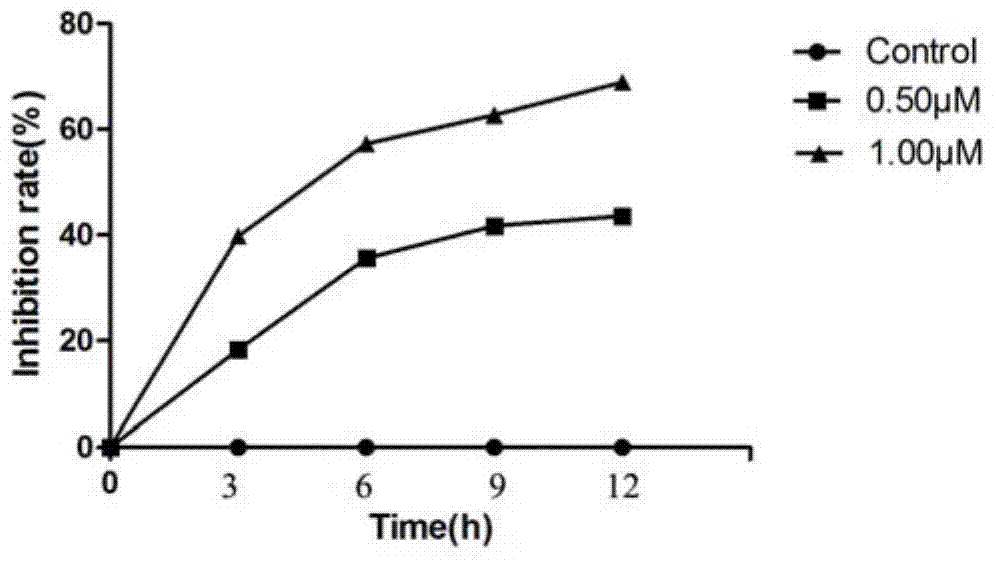Application of LukS-PV protein in preparation of medicine for inducing leukemia cell differentiation
A leukemia cell and protein technology, applied in the field of medicine, can solve the problems of retinoic acid syndrome, cytokine differentiation inducers, such as high price and tolerance, and achieve easy genetic modification and chemical modification, inhibit the growth of leukemia cells, reduce the Toxic effects
- Summary
- Abstract
- Description
- Claims
- Application Information
AI Technical Summary
Problems solved by technology
Method used
Image
Examples
Embodiment 1
[0029] In this example, HL-60 cells in the logarithmic growth phase were taken, and the cell concentration was adjusted to 2×10 5 / ml, added to a six-well plate, 2×10 per well 5 cells. After HL-60 cells were treated with LukS-PV at concentrations of 0, 0.50, and 1.00 μM for 3, 6, 9, and 12 hours, the cell growth was detected by MTS method.
[0030] Such as figure 1 As shown, the results showed that the growth inhibition curve of the normal control group was horizontal, and no growth inhibition was observed. LukS-PV can significantly inhibit the growth of HL-60 cells in a time-dose-dependent manner, that is, the inhibitory effect is more obvious when the dose is increased and the time is prolonged.
[0031] The human promyelocytic leukemia cell line HL-60 cells in this example were purchased from the Shanghai Cell Institute of the Chinese Academy of Sciences.
Embodiment 2
[0033] In this example, the HL-60 cells in the logarithmic growth phase were used to adjust the cell concentration to 2×10 5 / ml, added to a six-well plate, 2×10 per well 5 cells. After the cells were treated with 0, 0.50 μM, and 1.00 μM LukS-PV for 48 hours, the cell suspension was centrifuged and smeared, and the morphological changes of the cells were observed under a light microscope.
[0034] Such as figure 2 As shown, the effect of LukS-PV on the morphology of HL-60 cells was observed by Wright-Giemsa staining, and the magnification was 400 times. The results showed that after LukS-PV was applied to the cells for 48 hours, the cell morphology changed significantly under the light microscope. It is characterized by reduced cell volume, disappearance of nucleolus, significantly reduced nucleus, increased cytoplasm, condensed and thickened chromatin, reduced ratio of nucleoplasm, and nuclei are biased to one side.
[0035] Other implementations are the same as in Exampl...
Embodiment 3
[0037] In this embodiment, the THP-1 cells in the logarithmic growth phase were used to adjust the cell concentration to 2×10 5 / ml, the THP-1 cells of the human monocytic leukemia cell line in this example were purchased from the Shanghai Cell Institute of the Chinese Academy of Sciences. Other implementations are the same as in Example 2.
[0038] Such as image 3 As shown, the effect of LukS-PV on the morphology of THP-1 cells was observed under a direct microscope, and the magnification was 400 times. After LukS-PV was applied to the cells for 48 hours, the cell morphology was directly observed under a light microscope. Significant changes occurred. It showed that the cells changed from round, suspended to spindle-shaped, adhered, and showed adherent growth.
PUM
 Login to View More
Login to View More Abstract
Description
Claims
Application Information
 Login to View More
Login to View More - R&D
- Intellectual Property
- Life Sciences
- Materials
- Tech Scout
- Unparalleled Data Quality
- Higher Quality Content
- 60% Fewer Hallucinations
Browse by: Latest US Patents, China's latest patents, Technical Efficacy Thesaurus, Application Domain, Technology Topic, Popular Technical Reports.
© 2025 PatSnap. All rights reserved.Legal|Privacy policy|Modern Slavery Act Transparency Statement|Sitemap|About US| Contact US: help@patsnap.com



